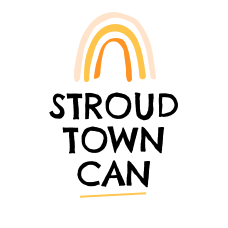Blue hearts and wild spaces
With climate chaos an impending reality and all-too common news reports such as "analysis of 353 species of wild bee and hoverfly species found the insects have been lost from a quarter of the places they were found in 1980" we are trying to make a difference here in Stroud. With over 97% of wildflower meadows having been destroyed since the Second World War, it is time to reverse this decline.
Wildflower turf and a blue heart at Clare Court
We are blessed with some fantastic green spaces in Stroud, places where our residents and visitors can find time and space to relax. Places where we are hoping to bring back more wildlife to start redressing the balance and to help people connect with the natural world, a known way to improve physical and mental health. A lack of connection with the natural world is arguably one reason for its degradation by the human race – if we love something we are more likely to care for it.
We are looking to provide a better habitat for pollinating insects by reducing the amount of land in our parks and other green spaces that are frequently mown – a mown turf provides precious little habitat or food for nature. A meadow area, one that is cut just once or twice per year, can hold in more carbon than a woodland, so by creating wildflower meadow areas, we are able to increase our carbon sequestration, or storage.
Within just a couple of seasons we have had some fantastic results, including various orchids on a number of urban sites that had previously stayed as non-flowering rosettes due to the cutting – and these areas have buzzed with pollinators through the summers, whilst rewarding the visitor with some beautiful plants and butterflies. We have been fortunate in having thin nutrient-poor soils over limestone – deeper and richer soils are not ideal for wildflower meadows.
As well as providing homes and food for many other species, reducing the cutting allows us to burn less fossil fuel in mowers, another way towards our 2030 carbon-neutral target.
We have been partnering with the Blue Campaign who are tirelessly promoting wildlife-friendly gardens and public spaces to provide the habitat for pollinating insects that we rely upon to pollinate much of our food worldwide. Each acre more meadow reduces carbon release from petrol or diesel-powered cutting machinery as well as locking carbon into the soil.
We are placing recycled blue hearts in places where we have reduced or stopped regular mowing – this is to show that we are doing so for good reason rather than due to our laziness! Look out for blue hearts in gardens, parks and on road verges in Stroud and all over the country – and with luck you'll be rewarded with some wonderful wildflowers and insect life.
Hedges and trees provide wildlife with some of the most useful corridors and stepping stones, as well as sucking in carbon, releasing oxygen and providing us with shade. We have recently planted new native-species hedges in two of our open spaces, and planted a small orchard in Park Gardens. We will continue to look for new locations for increasing the tree canopy cover in Stroud, currently some 18%, as trees can provide so may benefits from cooling the urban temperature, absorbing harmful pollutants and providing us with natural beauty.
Change is needed and we hope that in our small way we are helping. By working alongside partners such as the Blue Campaign and Stroud Nature, we also hope to encourage others to join in and help create or improve wildlife habitat and to provide corridors and stepping stones that will help the species we share this planet with to recover. By creating spaces within our town that help people to relax and make a connection with nature, we hope to encourage a more caring attitude towards the planet.

